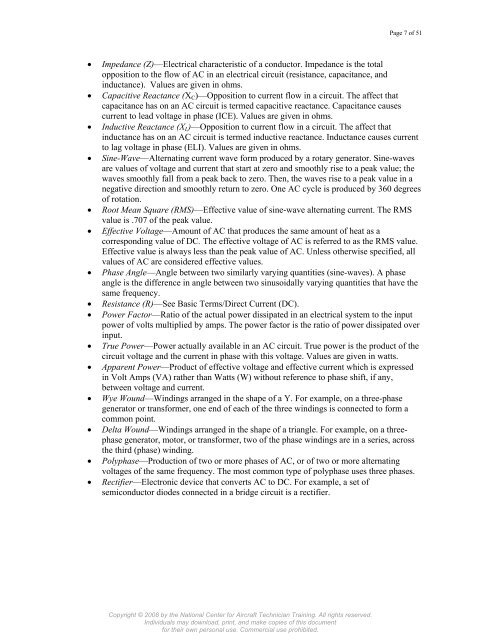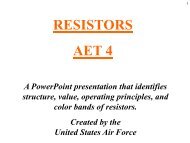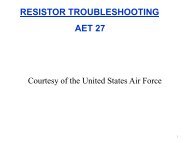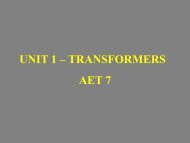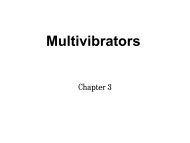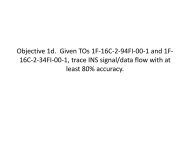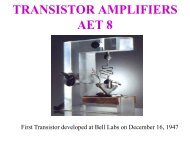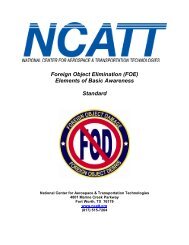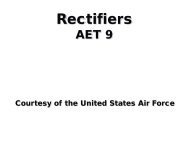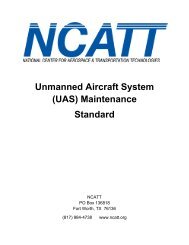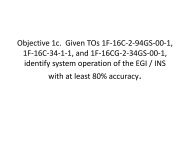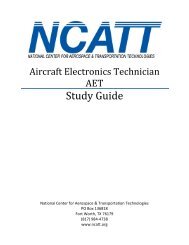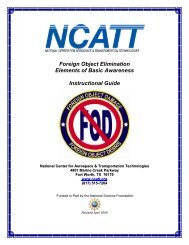(AET) Study Guide - NCATT
(AET) Study Guide - NCATT
(AET) Study Guide - NCATT
- No tags were found...
You also want an ePaper? Increase the reach of your titles
YUMPU automatically turns print PDFs into web optimized ePapers that Google loves.
Page 7 of 51• Impedance (Z)—Electrical characteristic of a conductor. Impedance is the totalopposition to the flow of AC in an electrical circuit (resistance, capacitance, andinductance). Values are given in ohms.• Capacitive Reactance (X C )—Opposition to current flow in a circuit. The affect thatcapacitance has on an AC circuit is termed capacitive reactance. Capacitance causescurrent to lead voltage in phase (ICE). Values are given in ohms.• Inductive Reactance (X L )—Opposition to current flow in a circuit. The affect thatinductance has on an AC circuit is termed inductive reactance. Inductance causes currentto lag voltage in phase (ELI). Values are given in ohms.• Sine-Wave—Alternating current wave form produced by a rotary generator. Sine-wavesare values of voltage and current that start at zero and smoothly rise to a peak value; thewaves smoothly fall from a peak back to zero. Then, the waves rise to a peak value in anegative direction and smoothly return to zero. One AC cycle is produced by 360 degreesof rotation.• Root Mean Square (RMS)—Effective value of sine-wave alternating current. The RMSvalue is .707 of the peak value.• Effective Voltage—Amount of AC that produces the same amount of heat as acorresponding value of DC. The effective voltage of AC is referred to as the RMS value.Effective value is always less than the peak value of AC. Unless otherwise specified, allvalues of AC are considered effective values.• Phase Angle—Angle between two similarly varying quantities (sine-waves). A phaseangle is the difference in angle between two sinusoidally varying quantities that have thesame frequency.• Resistance (R)—See Basic Terms/Direct Current (DC).• Power Factor—Ratio of the actual power dissipated in an electrical system to the inputpower of volts multiplied by amps. The power factor is the ratio of power dissipated overinput.• True Power—Power actually available in an AC circuit. True power is the product of thecircuit voltage and the current in phase with this voltage. Values are given in watts.• Apparent Power—Product of effective voltage and effective current which is expressedin Volt Amps (VA) rather than Watts (W) without reference to phase shift, if any,between voltage and current.• Wye Wound—Windings arranged in the shape of a Y. For example, on a three-phasegenerator or transformer, one end of each of the three windings is connected to form acommon point.• Delta Wound—Windings arranged in the shape of a triangle. For example, on a threephasegenerator, motor, or transformer, two of the phase windings are in a series, acrossthe third (phase) winding.• Polyphase—Production of two or more phases of AC, or of two or more alternatingvoltages of the same frequency. The most common type of polyphase uses three phases.• Rectifier—Electronic device that converts AC to DC. For example, a set ofsemiconductor diodes connected in a bridge circuit is a rectifier.Copyright © 2008 by the National Center for Aircraft Technician Training. All rights reserved.Individuals may download, print, and make copies of this documentfor their own personal use. Commercial use prohibited.


